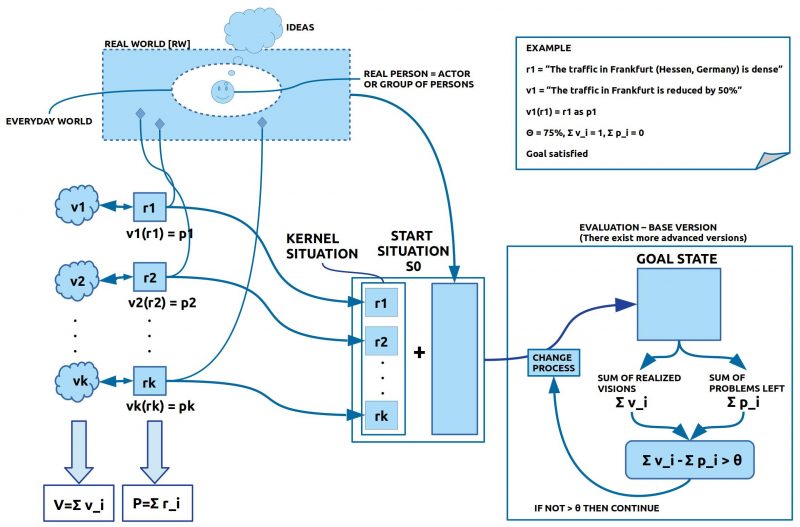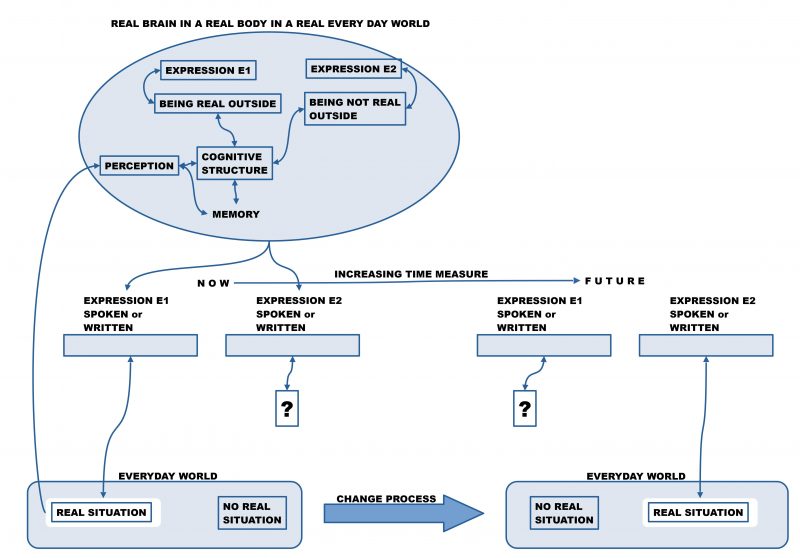Integrating Engineering and the Human Factor (info@uffmm.org) eJournal uffmm.org ISSN 2567-6458, Nov 23-28, 2020
Author: Gerd Doeben-Henisch
Email: gerd@doeben-henisch.de
CONTEXT
As described in the uffmm eJournal the wider context of this software project is a generative theory of cultural anthropology [GCA] which is an extension of the engineering theory called Distributed Actor-Actor Interaction [DAAI]. In the section Case Studies of the uffmm eJournal there is also a section about Python co-learning – mainly
dealing with python programming – and a section about a web-server with
Dragon. This document is part of the Case Studies section.
CONTENT
Applying the original P-V-Pref Document structure to real cases it became clear that the everyday logic behind the classification of facts into problems [P] or visions [V] follows a kind of logic hidden in the semantic space of the used expressions. This text explains this hidden logic and what this means for our application.

PDF DOCUMENT
- requirements-problem-vision-logic-v4-26nov2020 (last change: November 26, 2020)
- requirements-StartPoliticalProgram-v3-25nov2020 (last change: November 25, 2020)
- requirements-StartPoliticalProgram-24nov2020(last change: November 24, 2020, 10:45 am)
VIDEO [DE]
REMARK
(After first presentations of this video)
(Last change: November 28, 2020)
Confusion by different meanings
While the general view of the whole process is quite clear there arose some hot debate about the everyday situation of the experts (here: citizens) and the concepts ‘reality [R]‘, ‘vision [V] (imagination of a state which is not yet real)’, ‘problem [P]‘, and ‘preference [Pref]‘. The members of my zevedi-working group (located at the INM (Frankfurt, Hessen, Germany) as well as a citizen from Dieburg (Hessen, Germany) associated with ‘reality’ also the different kinds of emotions being active in a person and they classified an imagination about a future state also as being real in a concrete person. With such a setting of the concepts it became difficult to motivate the logic illustrated in the video. The video — based on the preceding paper — talks about a vision v, which can turn a reality r into a problem p, and thereby generating a preference Pref = (v,r). A preference can possibly become a trigger of some change process.
Looking ahead
Before clarifying this discussion let as have a look ahead to the overall change process which constitutes the heart of the komega-software. Beginning with October 18, 2020 the idea of this overall change process has been described in this blog. Having some given situation S, the komega software allows the construction of change rules X, which can be applied onto a given situation S and a builtin simulator [sim] will generate a follow up situation S’ like sim(X,S)=S’ — or short: X(S) = S’ –, a process which can be repeated by using the output S’ as new input for a new cycle. At any time of this cyclic process one can ask whether the actual output S’ can be classified as successful. What is called ‘successful’ depends from the applied criteria. For the komega software at least two criteria are used. The most basic one looks to the ectual end state S’ of the simulation and computes the difference between the occurences of vision statements V in S’ and the occurrences of real statements R having been declared at the beginning as problems P as part of the start situation S. Ideally the real statements classified as problems should have been disappeared and the vision statements should be present. If the difference is bigger than some before agreed threshold theta than the actual end state S’ will be classified as a success, as a goal state in the light of the visions of the preferences, which triggered the change process.
Vision statement
In the context of the whole change process a vision statement is an expression e associated with some everyday language L and which describes in the understanding of the experts a state, which is in our mindes conceivable, imaginable, which is not given as a real state, but can eventually become a real state in some future. This disctinction presupposes that the expert can distinguish between an idea in his consciousness which is associated with some real state outside his consciousness — associated with a real state — and an idea, which is only inside his consciousness — associated with an imaginated state –. Looking from a second person to the expert this second person can observe the body of the expert and the world surrounding the body and can speak of the real world and the real body of the expert, but the inner states of the expert are hidden for this second person. Thus from the point of view of this second person there are no real imaginations, no real future states. But the expert can utter some expression e which has a meaning describing some state, which as such is not yet real, but which possibly could become real if one would change the actual reality (the actual everyday life, the actual city …) accordingly. Thus a vision statement is understood here as an expression e from the everyday language L uttered by some expert having a meaning which can be understood by the other persons describing some imginated state, which is not yet real but could eventually become real in some future ahead.
Creating problems, composing preferences
If at least one vision statement v is known by some experts, then it can happen, that an expert does relate this vision with some given reality r as part of the everyday life or with some absent reality r. Example: if an expert classifies some part of the city as having too much traffic (r1) and he has the vision of changing this into a situation where the traffic is lowered down by X% (v1), then this vision statement v1 can help to understand other experts to interpret the reality r1 in the light of the visiin v1 as a problem v1(r1) = p1. Classifying some reality r1 into a problem p1 is understood in the context of the komega software as making the reality r1 a candidate for a possible change in the sense that r1 should be replaced by v1. Having taken this stance — seeing the reality r1 as a problem p1 by the vision v1 –, than the experts have created a so-called preference Pref = (v1, p1) saying that the experts are preferring the imaginated possibly future state v1 more than the actual problem p1.
There is the special case, that an expert has uttered a vision statement v but there is no given reality which can be stated in a real statement r. Example: A company thinks that it can produce some vaccine against the disease Y in two years from now, like v2=’there is a vaccine against disease Y in yy’. Actually there exists no vaccine, but a disease is attacking the people. Because it is known, that the people can be made immune against the disease by an appropriate vaccine it makes sense to state r2=’There is no vaccine against the disease Y available’. Having the vision v2 this can turn the reality r2 into a problem p2 allowing the preference Pref=(v2,p2).
Triggering actions
If a group of experts generated a vision v — by several and different reaons (including emotions) –, having associated this with some given eality r, and they decided to generate by v(r)=p a preference Pr =(v,p), then it can happen , that these experts decide to start a change process beginning now with the given problem p and ending up with a situation in some future where the problem p disappeared and the vision has become real.
Summing up
The komega software allows the planning and testing of change processes if the acting experts have at least one preference Pref based on at least one vision statement v and at least one real statement r.
BITS OF PHILOSOPHY

The above video (in German, DE) and the following lengthy remark after the video how to understand the basic concepts vision statement [v], real statement [r], problem statement [p], as well as preference [Pref] presuppose both a certain kind of philosophy. This philosophical point of view is outlined above in a simple drawing.
Basically there is a real human person (an actor) with a real brain embedded in some everyday world. The person can perceive parts of the every day world at every point of time. The most important reference point in time is the actual moment called NOW.
Inside the brain the human person can generate some cognitive structure triggered by perception, by memory and by some thinking. Having learned some everyday language L the human person can map the cognitive structure into an expression E associated with the language L. If the cognitive structure correlates with some real situation outside the body then the meaning of the expression E is classified as being a real statement, here named E1. But the brain can generate also cognitive structures and mapping these in expressions E without being actually correlated with some real situation outside. Such a statement is here called a vision statement, here named E2. A vision statement can eventually become correlated with some real situation outside in some future. In that case the vision statement transforms into a real statement E2, while the before mentioned real statement E1 can lose its correlation with a real situation.
FURTHER DISCUSSIONS
For further discussions have a look to this page too.

